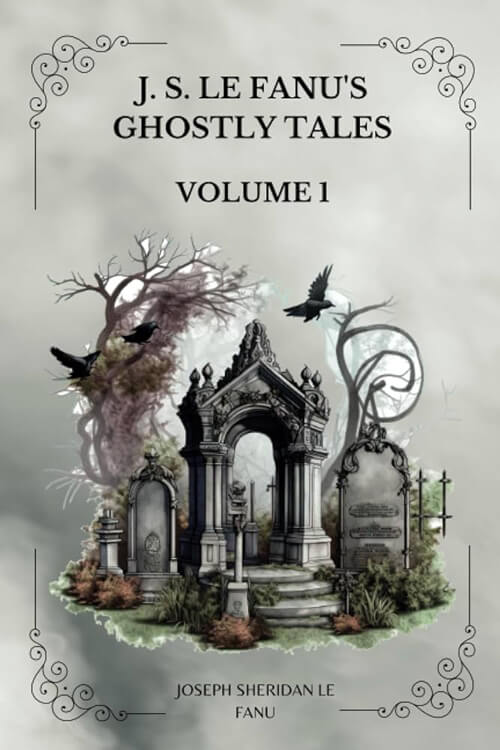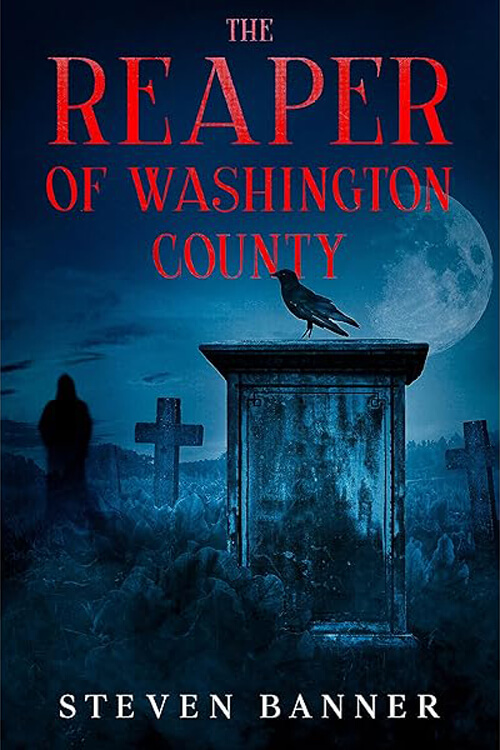
J. S. Le Fanu’s Ghostly Tales, Volume 1
There exists, at this moment, in good preservation a remarkable work of Schalken’s. The curious management of its lights constitutes, as usual in his pieces, the chief apparent merit of the picture. I say apparent, for in its subject, and not in its handling, however exquisite, consists its real value. The picture represents the interior of what might be a chamber in some antique religious building; and its foreground is occupied by a female figure, in a species of white robe, part of which is arranged to form a veil. The dress, however, is not that of any religious order. In her hand the figure bears a lamp, by which alone her figure and face are illuminated; and her features wear such an arch smile, as well becomes a pretty woman when practicing some prankish roguery; in the background, and, excepting where the dim red light of an expiring fire serves to define the form, in total shadow, stands the figure of a man dressed in the old Flemish fashion, in an attitude of alarm, his hand being placed upon the hilt of his sword, which he appears to be in the act of drawing.
There are some pictures, that impress one, I know not how, with a conviction that they represent not the mere ideal shapes and combinations that have floated through the imagination of the artist, but scenes, faces, and situations that have existed. There is in that strange picture, something that stamps it as the representation of a reality.
And such in truth it is, for it faithfully records a remarkable and mysterious occurrence, and perpetuates, in the face of the female figure, which occupies the most prominent place in the design, an accurate portrait of Rose Velderkaust, the niece of Gerard Douw, the first, and, I believe, the only love of Godfrey Schalken. My great-grandfather knew the painter well, and from Schalken himself he learned the fearful story of the painting, and from him too he ultimately received the picture itself as a bequest. The story and the picture have become heir-looms in my family, and having described the latter, I shall, if you please, attempt to relate the tradition that has descended with the canvas.
There are few forms on which the mantle of romance hangs more ungracefully than upon that of the uncouth Schalken—the boorish but most cunning worker in oils, whose pieces delight the critics of our day almost as much as his manners disgusted the refined of his own; and yet this man, so rude, so dogged, so slovenly, amid his celebrity, had in his obscure, but happier days, played the hero in a wild romance of mystery and passion.
When Schalken studied under the immortal Gerard Douw, he was a very young man; and despite his phlegmatic temperament, he at once fell over head and ears in love with the beautiful niece of his wealthy master. Rose Velderkaust was still younger than he, having not yet attained her seventeenth year, and, if tradition speaks truth, possessed all the soft and dimpling charms of the fair, light-haired Flemish maidens. The young painter loved honestly and fervently. His frank adoration was rewarded. He declared his love and extracted a faltering confession in return. He was the happiest and proudest painter in all Christendom. But there was somewhat to dash his elation; he was poor and undistinguished. He dared not ask old Gerard for the hand of his sweet ward. He must first win a reputation and competence.
Read or download Book
Joseph Sheridan Le Fanu
Joseph Thomas Sheridan Le Fanu (28 August 1814 – 7 February 1873) was an Irish writer of Gothic tales, mystery novels, and horror fiction. He was a leading ghost story writer of his time, central to the development of the genre in the Victorian era. M. R. James described Le Fanu as “absolutely in the first rank as a writer of ghost stories”. Three of his best-known works are the locked-room mystery Uncle Silas, the lesbian vampire novella Carmilla, and the historical novel The House by the Churchyard.
Work
Le Fanu worked in many genres but remains best known for his horror fiction. He was a meticulous craftsman and frequently reworked plots and ideas from his earlier writing in subsequent pieces. Many of his novels, for example, are expansions and refinements of earlier short stories. He specialized in tone and effect rather than “shock horror” and liked to leave important details unexplained and mysterious. He avoided overt supernatural effects: in most of his major works, the supernatural is strongly implied but a “natural” explanation is also possible. The demonic monkey in “Green Tea” could be a delusion of the story’s protagonist, who is the only person to see it; in “The Familiar”, Captain Barton’s death seems to be supernatural but is not witnessed, and the ghostly owl may be a real bird. This technique influenced later horror artists, both in print and on film (see, for example, the film producer Val Lewton’s principle of “indirect horror”). Though other writers have since chosen less subtle techniques, Le Fanu’s finest tales, such as the vampire novella Carmilla and the short story “Schalken the Painter”, remain some of the most powerful in the genre. He had an enormous influence on one of the 20th century’s most important ghost story writers, M. R. James, and although his work fell out of favor in the early part of the 20th century, towards the end of the century interest in his work increased and remains comparatively strong.
The Purcell Papers
His earliest twelve short stories, written between 1838 and 1840, purport to be the literary remains of an 18th-century Catholic priest called Father Purcell. They were published in the Dublin University Magazine and were later collected as The Purcell Papers (1880). They are mostly set in Ireland and include some classic stories of gothic horror, with gloomy castles, supernatural visitations from beyond the grave, madness, and suicide.






